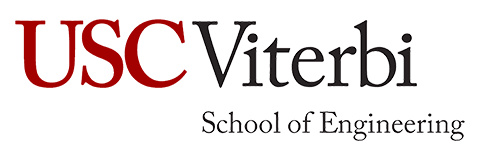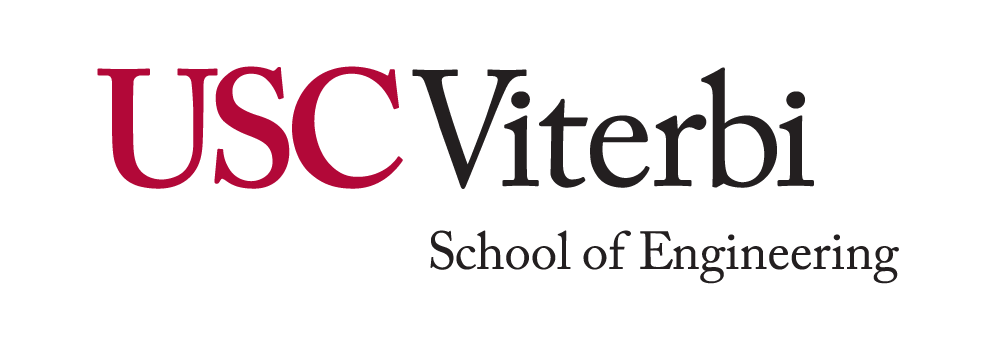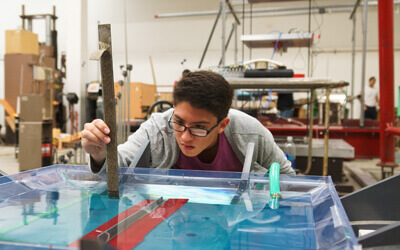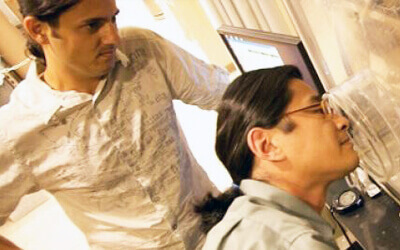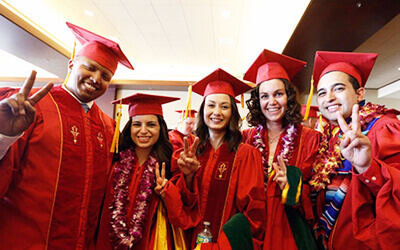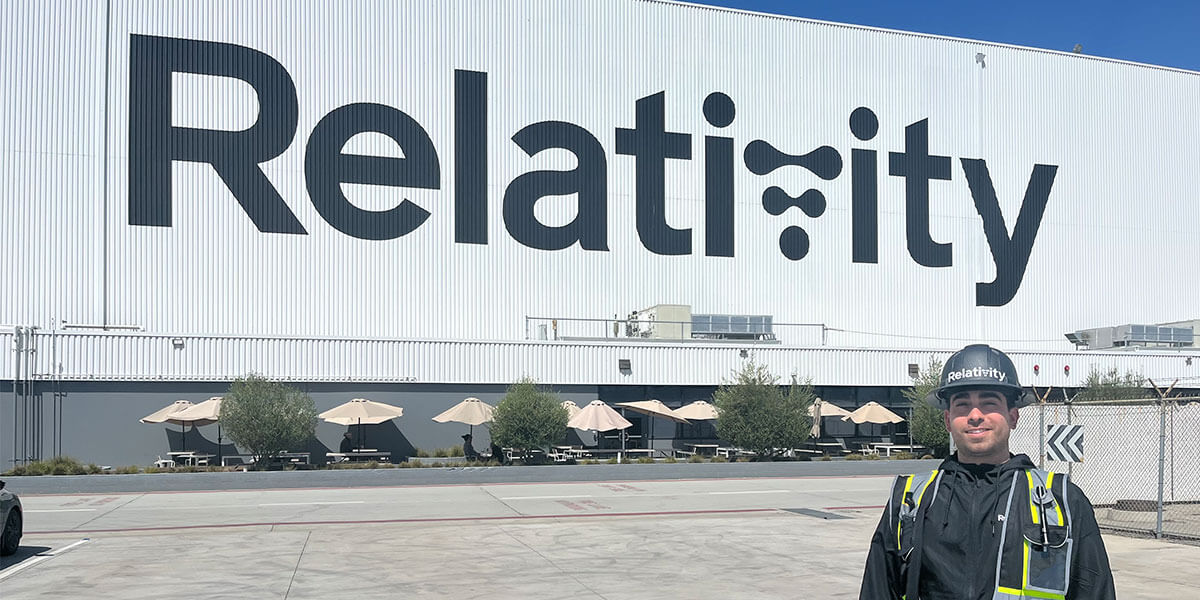
Alex Gasca (M.S. ’22), an infrastructure engineer at Relativity Space
You might associate civil engineering with life here on the ground – construction projects for buildings and bridges, optimizing public transit systems and managing water supply systems.
However, after four years working in construction management in New York City, Alex Gasca (M.S. ’22) – an infrastructure engineer at Relativity Space – started to wonder. He had earned a degree in civil engineering from Tufts University, but had his sights set on the aerospace industry. Somehow, he needed to make the leap from here to there, from earth to sky.
That’s when he discovered the master’s program in Emerging Technologies in Construction (EmTech) offered by USC’s Sonny Astani Department of Civil & Environmental Engineering.
“Back in New York, I was part of the team that built Little Island, one of the largest floating island parks,” he reflected. “That was exciting to me – the possibility of building things that were future-forward, fun and human-centered. I wanted to work on those kinds of projects at a much larger scale, pushing the boundaries of what was associated with my particular background and skills. Then, I landed on the idea of working at an aerospace company.”
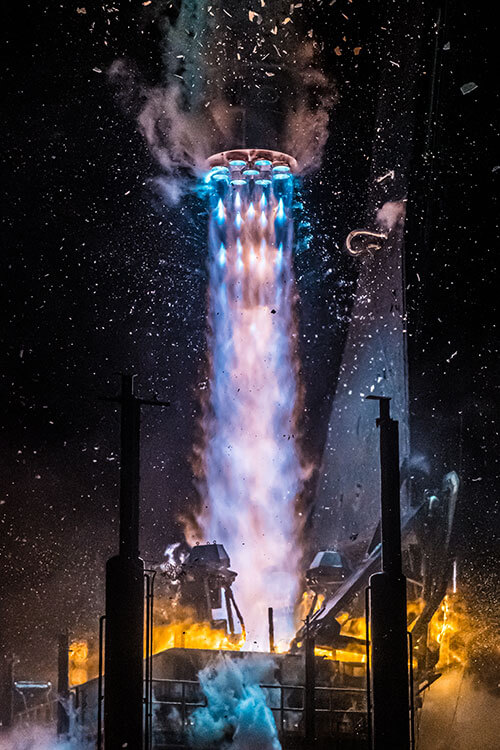
Launch of the Terran 1 rocket
Gasca recognized that the construction industry was comparatively slow to integrate new technology, and he knew he had to sharpen his skillset if he planned to enter a new field.
For Gasca, the EmTech program at the USC Viterbi School of Engineering directly addressed what he considered his “pain points,” while also enabling him to build upon his prior experience in construction management. The program trains students to keep pace with technological change, with a focus on leveraging data to optimize the built environment for sustainability, as well as streamlining the construction management process through computational methods and advanced simulations.
“The director of the program, Professor David Gerber, used to refer to a ‘lingua franca’ – that idea of having a language that allows you to communicate between multiple approaches and disciplines,” said Gasca. “We didn’t need to be an expert in all fields, but we did need to know how to speak the language.”
Gasca was able to apply that fluency when a role as an infrastructure engineer came up at Relativity Space, the company renowned for developing the first successfully launched 3D printed rocket.
Relativity Space was founded by two USC Viterbi alumni, Tim Ellis (B.S. ’12, M.S. ’13) and Jordan Noone (B.S. ’14), and the 2023 launch of the Terran 1 rocket was a breakthrough for the space industry in terms of cost, speed, design efficiency and sustainability.
The company is currently developing Terran R, a medium-to-heavy lift rocket designed for re-use, with the goal of enabling government agencies and private companies to launch satellites quickly and easily without having to rely on hitching a ride on a larger rocket.
Gasca immediately felt aligned with the company’s ambitious goals. A new approach to rocketry requires inventing new tools and systems; for Relativity Space, being among the top commercial launch companies was also dependent on being a leader in manufacturing.
“Much of the space industry is now geared towards establishing a base on Mars, paving the way for interplanetary life,” said Gasca. “It’s about expanding the possibilities of the human experience. And before we can get to Mars, we need to build out the infrastructure to support Relativity’s manufacturing goals here on Earth.”
When he started his new role, Gasca felt confident that his previous professional experience and the skills he had learned during the EmTech program had equipped him for the career pivot. “I’m not an aerospace engineer, but I’m able to leverage my background in civil engineering and construction to understand production needs and help bring them to life,” he explained. “I develop complex tools, test stands and machinery that enables us to build rockets and establish a strong manufacturing facility.”
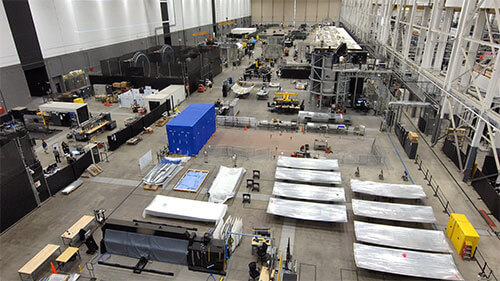
Terran R panels at the Relativity Space Wormhole Facility in Long Beach, California
The twists and turns of his career so far have taught Gasca that he feels most comfortable at the cutting-edge – he’s driven by the vast potential of the unknown and a future-oriented approach that isn’t limited to the scope of possibilities currently achievable.
“The EmTech program was all about the proactive adoption of new technology, quickly gaining and understanding of those tools and how they produced new ways of thinking within the construction industry,” said Gasca.
“But then, you have to think carefully about where you want apply your skills after graduating,” he continued. “The construction industry is notoriously slow to integrate new approaches. That’s why it was so exciting to join Relativity Space, where the scope of the project extends far beyond what we’re currently building and the methods we’re currently using. I’ve received so much support from my manager when it comes to creative solutions and testing new technology that helps us to build more efficiently.”
Clearly, for Gasca, Relativity Space is a perfect fit. Back when he first decided to pivot from conventional construction management to aerospace innovation, he already had the optimism and the vision to think beyond the channels of an expected career path. “I realized I needed to expand what I thought was possible,” he said. “Now, that’s part of my job.”
Published on April 23rd, 2025
Last updated on April 23rd, 2025
